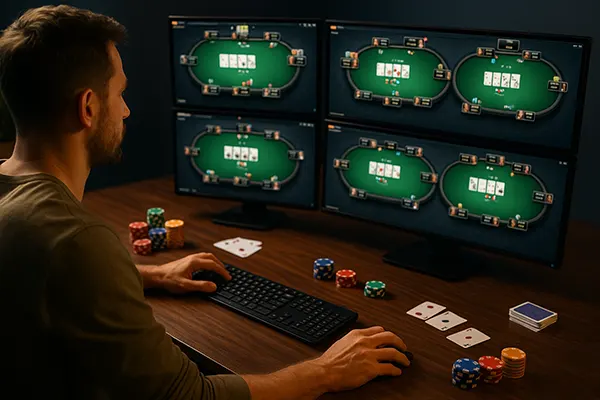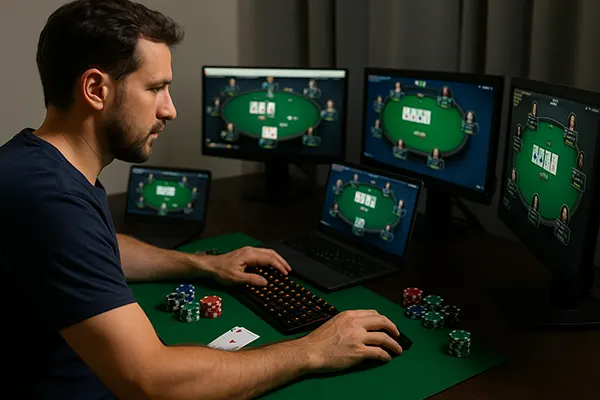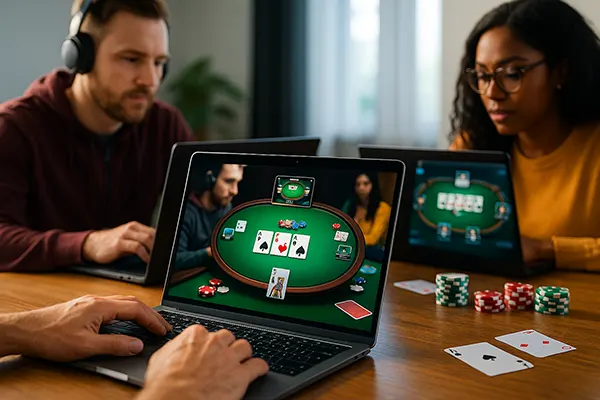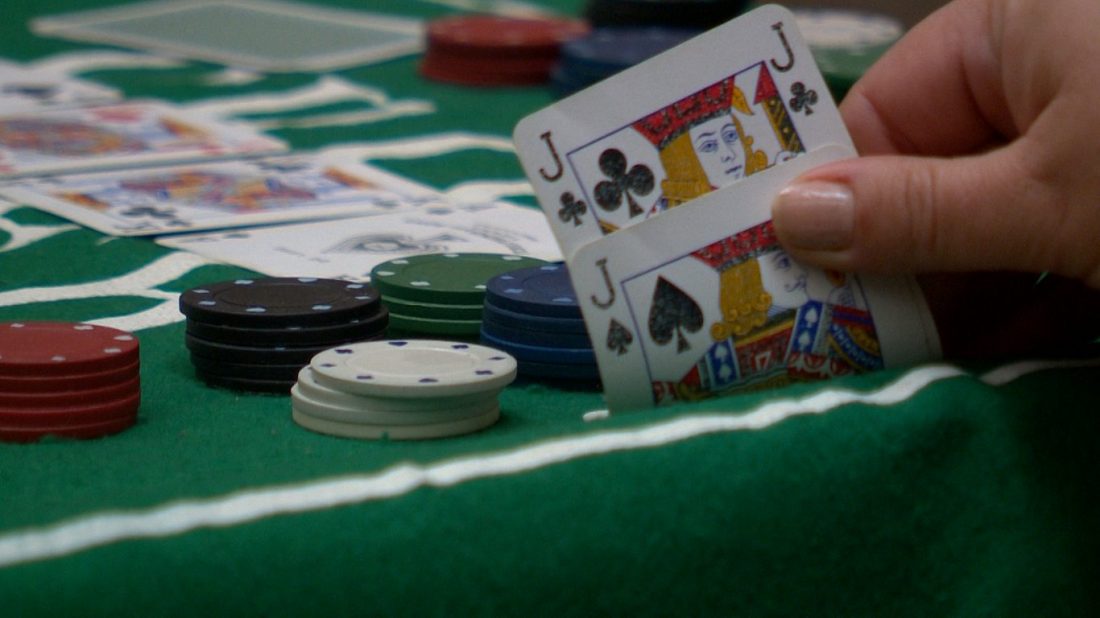
Multi-Tabling in Cash Games: How to Play Poker Effectively at Several Tables Simultaneously
Multi-tabling in cash games is a skill that separates recreational players from serious grinders. Managing several tables at once allows you to increase your hourly rate, sharpen your focus, and build long-term discipline. However, it also requires excellent time management, awareness, and a solid technical setup. In 2025, with advanced poker tools and more competitive online environments, mastering multi-tabling has become a vital part of professional poker strategy.
What Multi-Tabling Really Means in Modern Poker
Multi-tabling refers to the practice of playing more than one cash game table simultaneously. Instead of waiting for hands to play out on a single table, professionals open multiple ones to increase the number of decisions they make per hour. This practice enhances the potential for profit but also tests a player’s concentration and endurance. Most modern poker clients support smooth transitions between tables, minimising delays and making multi-tabling more efficient than ever before.
While some players manage two or three tables comfortably, others play ten or more. The right number depends on your level of experience, bankroll, and ability to make decisions quickly without sacrificing accuracy. Playing too many tables too soon can lead to mechanical errors or missed opportunities, especially in marginal spots that require creative thinking. The balance between volume and quality remains the cornerstone of effective multi-tabling.
In 2025, online poker rooms continue to refine their interfaces, offering features such as auto-rebuy options, multi-table layouts, and statistical overlays. These improvements enable serious players to operate with greater efficiency. Nevertheless, even the best tools cannot replace the mental stamina and structured approach needed to sustain performance over long sessions.
Why Multi-Tabling Demands More Than Speed
Many players mistakenly believe that multi-tabling is only about reacting fast. In reality, success depends on maintaining a deep understanding of ranges, position, and opponent tendencies across multiple screens. Quick thinking is important, but informed decision-making is what generates consistent profit. Experienced players train their minds to recognise patterns and automate basic decisions, freeing up mental space for complex hands.
Concentration becomes a crucial skill. Each table may present a different game dynamic: one full of aggressive opponents, another dominated by passive limpers. Switching context rapidly without losing precision is a learned ability. Some professionals use colour-coding systems and advanced HUDs to keep track of opponents and key statistics, allowing them to react accurately within seconds.
Ultimately, multi-tabling is not a test of reaction time but of composure. Players who maintain emotional balance after bad beats or swings across several tables show true professionalism. The difference between a solid grinder and an overwhelmed player lies in the ability to reset focus instantly and continue executing correct decisions under pressure.
Practical Tips for Effective Multi-Tabling
Before attempting to play multiple tables, it’s vital to develop a strong single-table strategy. Only when you are comfortable making decisions automatically at one table should you expand your session. Starting small and gradually increasing the number of tables ensures that your win rate remains stable. Adding volume too quickly can turn profitable play into chaos, as even minor distractions can cause costly mistakes.
Hardware setup also matters. A dual or triple monitor configuration, ergonomic mouse, and stable internet connection significantly improve your efficiency. Professional players often customise layouts to keep important tables in central view while relegating secondary ones to peripheral positions. Keyboard shortcuts and table hotkeys further reduce reaction time and keep gameplay smooth.
Time management is another essential factor. Setting clear limits for each session, taking short breaks, and monitoring tilt indicators prevent mental fatigue. Tracking tools like PokerTracker or Hold’em Manager allow you to analyse hands post-session, identifying leaks specific to multi-tabling environments. Consistent review helps refine strategies and maintain a sustainable balance between quantity and quality.
How to Maintain Focus and Consistency
Maintaining focus during long multi-table sessions requires discipline. Professional players build routines that include hydration, breaks, and minimal distractions. Playing for hours without structure leads to decision fatigue and emotional burnout. Short, focused sessions with defined objectives yield better long-term performance than endless grinding.
Developing a rhythm between tables is equally important. Instead of reacting impulsively, train your mind to follow a systematic decision process. This includes checking stack sizes, position, and previous actions before making any move. Once these checks become habitual, you’ll handle multiple tables without stress or confusion.
Finally, adaptability is the hallmark of every successful multi-tabler. As poker evolves, so do opponent strategies. Regularly updating your game knowledge, studying new solver outputs, and adjusting ranges according to table tendencies ensure you remain ahead of the competition. Continuous learning is the foundation of consistency in modern poker.

The Future of Multi-Tabling: Technology and Psychology
As of 2025, artificial intelligence tools, heads-up displays, and real-time solvers have revolutionised how players analyse opponents. However, their usage is increasingly regulated by poker rooms to ensure fair play. Successful multi-tablers must therefore strike a balance between ethical gameplay and analytical precision. Understanding how to leverage legal aids without violating terms of service is a professional responsibility.
Psychologically, the future of multi-tabling revolves around cognitive endurance. With the human attention span constantly challenged by multitasking, mental training techniques such as mindfulness and focus exercises are becoming part of professional poker routines. Many players work with performance coaches to improve concentration and decision-making resilience.
Technological advancements are also shaping ergonomics. Eye-tracking setups, screen filters, and adaptive table positioning reduce strain and promote better performance over time. Combining mental preparation with a healthy playing environment helps players achieve long-term stability while maintaining sharp strategic precision across multiple tables.
Building a Long-Term Multi-Tabling Career
Consistency and sustainability are the pillars of a professional poker career. Multi-tabling is demanding, and without structure, even the most talented players can burn out. Building routines, maintaining physical health, and tracking psychological well-being are as vital as mastering poker theory. The goal is not only to maximise short-term profits but also to ensure career longevity.
Financial discipline also matters. Multi-tablers face higher variance because they play many hands simultaneously. Proper bankroll management, conservative buy-in selection, and accurate variance tracking protect against major downswings. Professionals often use separate accounts or spreadsheets to monitor profitability by table type and stake level.
In the end, effective multi-tabling is an art form — a combination of technical skill, mental endurance, and ethical awareness. Players who commit to continuous improvement, balanced gameplay, and disciplined lifestyle choices will thrive in the evolving poker landscape of 2025 and beyond.



